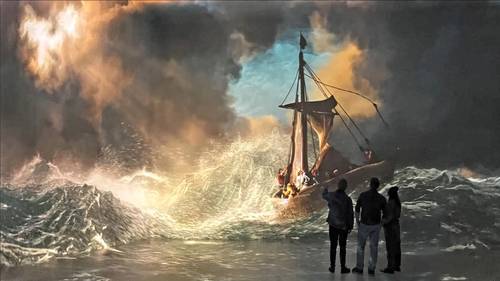The experience of the stormy sea that rocks a small boat while the crew members cling desperately to avoid being shipwrecked in the painting The storm on the Sea of Galilee (1633), by Rembrandt, becomes even more palpable with a striking immersive and multisensory exhibition on display at London’s Frameless gallery.
The oil painting by the Dutch painter, the only seascape in his career, is about the scene in which while Jesus and the 12 apostles are about to capsize, before the Messiah worked the miracle of calming the waters, according to the Gospel of Saint Frames.
The British visual development company Cinesite was once again present The storm on the Sea of Galilee, painting of which a few images remain after its theft in 1990 in a spectacular robbery at the Isabella Stewart Gardner Museum in Boston.
The firm is partnered with Frameless Creative, responsible for the UK’s largest permanent digital art experience and the first in London. This alliance has made it possible to relive the experience and enhance its drama through multisensory elements.
Cinesite reported that the first piece it provided to Frameless, since the beginning of their collaboration earlier this year, is a reinterpretation of the Rembrandt piece in the exhibition The world around us.
In that project, the firm explained, the Creating convincing real effects was vital to conveying the force of the storm. Simulation techniques were used to create controllable open water: wave height, frequency, fine spray and runoff. Added fog passes to backlight water and spray
.
In recent weeks, images of the Rembrandt in an overwhelming movement have gone viral on social networks and even false news spread that it was made with artificial intelligence.
Cinesite released a small capsule of how they developed the immersive experience, for which they received a VES award last February, which is awarded to the art and innovation of visual effects in film, animation, television, advertisements and video games. as well as the supervisors, producers and visual effects artists who bring this work to life.
In that document they commented on the challenge of bringing the painting to the screen and to movement, so they began by seeing how the work could work in a third-dimensional environment and, for example, they carried out raw tests to “see how they could swell the waves without completely obscuring the boat and staying faithful to its characteristic angle, without deviating it too much from the axis.
The same minimalist approach was applied to animating people, and creating convincing real-world effects was vital to conveying the force of the storm.
. We also worked with the movement of the waters and clouds, each separately and in detail, as well as the incidental light on the boat.
The scene exhibited in the Frameless gallery allows you to feel the terror and agitation of the apostles in the youthful masterpiece of the Dutch artist. In it, Rembrandt portrayed himself as one of the 14 people occupying the boat: the one holding the mast rope and looking towards the viewer.
Ryan Atwood, creative director of Frameless, explained on the gallery’s website that This process has consisted of exploring how we can leverage the team’s cinematic experience to improve our overall narrative ability and the level of detail and effects of the works, truly investing in the emotional connection that our visitors can have with the work. The results are spectacular
.
The London venue highlighted that for centuries painters have captured the complexity of the world, filling canvases with astonishing landscapes, alternative realities, sublime colors and supreme purity, seeking to express the very essence of humanity. Today, technology allows us to get closer than ever to these masterpieces.
.
The Frameless gallery provides a multisensory experience to 41 other masterpieces in four galleries, where in addition to the Rembrandt piece, creations by Cezanne, Kandinsky, Monet, Dalí, Van Gogh, Klimt, Klee, Mondrian, Munch, Hieronymus Bosch and Max Ernst, among others.
